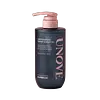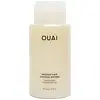What's inside
What's inside
 Key Ingredients
Key Ingredients

 Benefits
Benefits

 Concerns
Concerns

 Ingredients Side-by-side
Ingredients Side-by-side

Water
Skin ConditioningSodium Laureth Sulfate
CleansingAmmonium Lauryl Sulfate
CleansingCocamidopropyl Betaine
CleansingDipropylene Glycol
HumectantParfum
MaskingPPG-3 Myristyl Ether
EmollientSodium Benzoate
MaskingPolyquaternium-10
Sodium Chloride
MaskingCaprylyl Glycol
EmollientCitric Acid
BufferingHydroxypropyl Guar Hydroxypropyltrimonium Chloride
Hexyl Cinnamal
PerfumingPhenoxyethanol
PreservativePentasodium Pentetate
Sodium Carbonate
BufferingLimonene
PerfumingCitronellol
PerfumingGeraniol
PerfumingHydrolyzed Milk Protein
Skin ConditioningHydrolyzed Collagen
EmollientButylene Glycol
Humectant1,2-Hexanediol
Skin ConditioningHydrolyzed Silk
HumectantMentha Piperita Leaf Extract
Skin ConditioningChamomilla Recutita Flower Extract
MaskingMonarda Didyma Leaf Extract
Skin ConditioningRosmarinus Officinalis Leaf Extract
AntimicrobialFreesia Refracta Extract
Skin ConditioningLavandula Angustifolia Extract
Skin ConditioningHydrolyzed Keratin
HumectantEthyl Hexanediol
SolventSilk Amino Acids
HumectantEthylhexylglycerin
Skin ConditioningCamellia Japonica Seed Oil
EmollientOlea Europaea Fruit Oil
MaskingArgania Spinosa Kernel Oil
EmollientMacadamia Integrifolia Seed Oil
Skin ConditioningHelianthus Annuus Seed Oil
EmollientHydrolyzed Corn Protein
Skin ConditioningHydrolyzed Soy Protein
HumectantHydrolyzed Wheat Protein
Skin ConditioningLeucine
Skin ConditioningTaurine
BufferingIsoleucine
Skin ConditioningValine
MaskingAspartic Acid
MaskingOrnithine
Skin ConditioningGlutamic Acid
HumectantGlycine
BufferingGlutamine
Skin ConditioningCystine
MaskingMethionine
Skin ConditioningTyrosine
MaskingLysine
Skin ConditioningAlanine
MaskingPhenylalanine
MaskingSerine
MaskingTryptophan
MaskingThreonine
Arginine
MaskingHistidine
HumectantAsparagine
MaskingProline
Skin ConditioningWater, Sodium Laureth Sulfate, Ammonium Lauryl Sulfate, Cocamidopropyl Betaine, Dipropylene Glycol, Parfum, PPG-3 Myristyl Ether, Sodium Benzoate, Polyquaternium-10, Sodium Chloride, Caprylyl Glycol, Citric Acid, Hydroxypropyl Guar Hydroxypropyltrimonium Chloride, Hexyl Cinnamal, Phenoxyethanol, Pentasodium Pentetate, Sodium Carbonate, Limonene, Citronellol, Geraniol, Hydrolyzed Milk Protein, Hydrolyzed Collagen, Butylene Glycol, 1,2-Hexanediol, Hydrolyzed Silk, Mentha Piperita Leaf Extract, Chamomilla Recutita Flower Extract, Monarda Didyma Leaf Extract, Rosmarinus Officinalis Leaf Extract, Freesia Refracta Extract, Lavandula Angustifolia Extract, Hydrolyzed Keratin, Ethyl Hexanediol, Silk Amino Acids, Ethylhexylglycerin, Camellia Japonica Seed Oil, Olea Europaea Fruit Oil, Argania Spinosa Kernel Oil, Macadamia Integrifolia Seed Oil, Helianthus Annuus Seed Oil, Hydrolyzed Corn Protein, Hydrolyzed Soy Protein, Hydrolyzed Wheat Protein, Leucine, Taurine, Isoleucine, Valine, Aspartic Acid, Ornithine, Glutamic Acid, Glycine, Glutamine, Cystine, Methionine, Tyrosine, Lysine, Alanine, Phenylalanine, Serine, Tryptophan, Threonine, Arginine, Histidine, Asparagine, Proline
Water
Skin ConditioningSodium C14-16 Olefin Sulfonate
CleansingCocamidopropyl Betaine
CleansingSodium Methyl Cocoyl Taurate
CleansingCocamide Mipa
EmulsifyingGlycol Distearate
EmollientParfum
MaskingAmodimethicone
Hydroxypropyl Guar Hydroxypropyltrimonium Chloride
Glycerin
HumectantCitrus Japonica Fruit Extract
Skin ConditioningPanthenol
Skin ConditioningHydrolyzed Keratin
HumectantPolyquaternium-7
Orbignya Oleifera Seed Oil
EmollientCocos Nucifera Oil
MaskingPEG-150 Distearate
EmulsifyingSodium Lauroyl Glycinate
CleansingCetrimonium Chloride
AntimicrobialC11-15 Pareth-7
EmulsifyingLaureth-9
EmulsifyingTrideceth-12
EmulsifyingCocoglucosides Hydroxypropyltrimonium Chloride
CleansingAcrylates Copolymer
Tocopherol
AntioxidantPEG-200 Hydrogenated Glyceryl Palmate
CleansingPEG-7 Glyceryl Cocoate
EmulsifyingDisodium EDTA
Citric Acid
BufferingSodium Chloride
MaskingSodium Hydroxide
BufferingTetrasodium EDTA
Phenoxyethanol
PreservativeSodium Benzoate
MaskingPotassium Sorbate
PreservativeBenzyl Alcohol
PerfumingBenzyl Salicylate
PerfumingLimonene
PerfumingHexyl Cinnamal
PerfumingCI 15985
Cosmetic ColorantWater, Sodium C14-16 Olefin Sulfonate, Cocamidopropyl Betaine, Sodium Methyl Cocoyl Taurate, Cocamide Mipa, Glycol Distearate, Parfum, Amodimethicone, Hydroxypropyl Guar Hydroxypropyltrimonium Chloride, Glycerin, Citrus Japonica Fruit Extract, Panthenol, Hydrolyzed Keratin, Polyquaternium-7, Orbignya Oleifera Seed Oil, Cocos Nucifera Oil, PEG-150 Distearate, Sodium Lauroyl Glycinate, Cetrimonium Chloride, C11-15 Pareth-7, Laureth-9, Trideceth-12, Cocoglucosides Hydroxypropyltrimonium Chloride, Acrylates Copolymer, Tocopherol, PEG-200 Hydrogenated Glyceryl Palmate, PEG-7 Glyceryl Cocoate, Disodium EDTA, Citric Acid, Sodium Chloride, Sodium Hydroxide, Tetrasodium EDTA, Phenoxyethanol, Sodium Benzoate, Potassium Sorbate, Benzyl Alcohol, Benzyl Salicylate, Limonene, Hexyl Cinnamal, CI 15985
 Reviews
Reviews

Ingredients Explained
These ingredients are found in both products.
Ingredients higher up in an ingredient list are typically present in a larger amount.
Citric Acid is an alpha hydroxy acid (AHA) naturally found in citrus fruits like oranges, lemons, and limes.
Like other AHAs, citric acid can exfoliate skin by breaking down the bonds that hold dead skin cells together. This helps reveal smoother and brighter skin underneath.
However, this exfoliating effect only happens at high concentrations (20%) which can be hard to find in cosmetic products.
Due to this, citric acid is usually included in small amounts as a pH adjuster. This helps keep products slightly more acidic and compatible with skin's natural pH.
In skincare formulas, citric acid can:
While it can provide some skin benefits, research shows lactic acid and glycolic acid are generally more effective and less irritating exfoliants.
Most citric acid used in skincare today is made by fermenting sugars (usually from molasses). This synthetic version is identical to the natural citrus form but easier to stabilize and use in formulations.
Read more about some other popular AHA's here:
Learn more about Citric AcidCocamidopropyl Betaine is a fatty acid created by mixing similar compounds in coconut oil and dimethylaminopropylamine, a compound with two amino groups.
This ingredient is a surfactant and cleanser. It helps gather the dirt, pollutants, and other impurities in your skin to be washed away. It also helps thicken a product and make the texture more creamy.
Being created from coconut oil means Cocamidopropyl Betaine is hydrating for the skin.
While Cocamidopropyl Betaine was believed to be an allergen, a study from 2012 disproved this. It found two compounds in unpure Cocamidopropyl Betaine to be the irritants: aminoamide and 3-dimethylaminopropylamine. High-grade and pure Cocamidopropyl Betaine did not induce allergic reactions during this study.
Learn more about Cocamidopropyl BetaineHexyl Cinnamal is a fragrance ingredient with a similar scent to jasmine. It can be naturally found in chamomile essential oil.
This ingredient is a known EU allergen and may sensitize the skin. The EU requires this ingredient to be listed separately on an ingredients list.
Hexyl Cinnamal is not water soluble but is soluble in oils.
Learn more about Hexyl CinnamalHydrolyzed Keratin is derived from keratin. Keratin is a large protein that is naturally found in our hair and skin.
Studies show keratin is able to seal broken hair cuticles, helping to prevent split ends and breakage.
As a humectant, hydrolyzed keratin helps draw moisture from the air to your hair and skin. This helps keep your skin and hair hydrated.
Learn more about Hydrolyzed KeratinWe don't have a description for Hydroxypropyl Guar Hydroxypropyltrimonium Chloride yet.
Limonene is a fragrance that adds scent and taste to a formulation.
It's found in the peel oil of citrus fruits and other plants such as lavender and eucalyptus. The scent of limonene is generally described as "sweet citrus".
Limonene acts as an antioxidant, meaning it helps neutralize free radicals.
When exposed to air, oxidized limonene may sensitize the skin. Because of this, limonene is often avoided by people with sensitive skin.
The term 'fragrance' is not regulated in many countries. In many cases, it is up to the brand to define this term. For instance, many brands choose to label themselves as "fragrance-free" because they are not using synthetic fragrances. However, their products may still contain ingredients such as essential oils that are considered a fragrance.
Learn more about LimoneneParfum is a catch-all term for an ingredient or more that is used to give a scent to products.
Also called "fragrance", this ingredient can be a blend of hundreds of chemicals or plant oils. This means every product with "fragrance" or "parfum" in the ingredients list is a different mixture.
For instance, Habanolide is a proprietary trade name for a specific aroma chemical. When used as a fragrance ingredient in cosmetics, most aroma chemicals fall under the broad labeling category of “FRAGRANCE” or “PARFUM” according to EU and US regulations.
The term 'parfum' or 'fragrance' is not regulated in many countries. In many cases, it is up to the brand to define this term.
For instance, many brands choose to label themselves as "fragrance-free" because they are not using synthetic fragrances. However, their products may still contain ingredients such as essential oils that are considered a fragrance by INCI standards.
One example is Calendula flower extract. Calendula is an essential oil that still imparts a scent or 'fragrance'.
Depending on the blend, the ingredients in the mixture can cause allergies and sensitivities on the skin. Some ingredients that are known EU allergens include linalool and citronellol.
Parfum can also be used to mask or cover an unpleasant scent.
The bottom line is: not all fragrances/parfum/ingredients are created equally. If you are worried about fragrances, we recommend taking a closer look at an ingredient. And of course, we always recommend speaking with a professional.
Learn more about ParfumPhenoxyethanol is a preservative that has germicide, antimicrobial, and aromatic properties. Studies show that phenoxyethanol can prevent microbial growth. By itself, it has a scent that is similar to that of a rose.
It's often used in formulations along with Caprylyl Glycol to preserve the shelf life of products.
Sodium Benzoate is a preservative. It's used in both cosmetic and food products to inhibit the growth of mold and bacteria. It is typically produced synthetically.
Both the US FDA and EU Health Committee have approved the use of sodium benzoate. In the US, levels of 0.1% (of the total product) are allowed.
Sodium benzoate works as a preservative by inhibiting the growth of bacteria inside of cells. It prevents the cell from fermenting a type of sugar using an enzyme called phosphofructokinase.
It is the salt of benzoic acid. Foods containing sodium benzoate include soda, salad dressings, condiments, fruit juices, wines, and snack foods.
Studies for using ascorbic acid and sodium benzoate in cosmetics are lacking, especially in skincare routines with multiple steps.
We always recommend speaking with a professional, such as a dermatologist, if you have any concerns.
Learn more about Sodium BenzoateChances are, you eat sodium chloride every day. Sodium Chloride is also known as table salt.
This ingredient has many purposes in skincare: thickener, emulsifier, and exfoliator.
You'll most likely find this ingredient in cleansers where it is used to create a gel-like texture. As an emulsifier, it also prevents ingredients from separating.
There is much debate on whether this ingredient is comedogenic. The short answer - comedogenic ratings don't tell the whole story. Learn more about comegodenic ratings here.
The concensus about this ingredient causing acne seems to be divided. Research is needed to understand if this ingredient does cause acne.
Scrubs may use salt as the primary exfoliating ingredient.
Learn more about Sodium ChlorideWater. It's the most common cosmetic ingredient of all. You'll usually see it at the top of ingredient lists, meaning that it makes up the largest part of the product.
So why is it so popular? Water most often acts as a solvent - this means that it helps dissolve other ingredients into the formulation.
You'll also recognize water as that liquid we all need to stay alive. If you see this, drink a glass of water. Stay hydrated!
Learn more about Water